Dollar coins have been minted in the United States in gold, silver, and base metal versions. The term silver dollar is often used for any large white metal coin issued by the United States with a face value of one dollar, although purists insist that a dollar is not silver unless it contains some of that metal. Silver dollars, the first dollar coin issue, were minted beginning in 1794. Gold dollars and gold-colored dollars have also been produced by the United States. The Sacagawea and Presidential dollars are often referred to as "golden dollars".
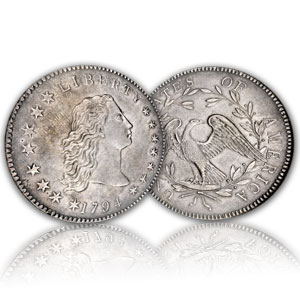
The Flowing Hair dollar was the first dollar coin issued by the United States federal government. The coin was minted in 1794 and 1795; its size and weight were based on the Spanish dollar, which was popular in trade throughout the Americas.
In 1791, following a study by Alexander Hamilton, Congress passed a joint resolution calling for the establishment of a national mint. Later that year, in his third State of the Union address, President George Washington urged Congress to provide for a mint, which was officially authorized by the Coinage Act of 1792. Despite the authorization, silver and gold coins were not struck until 1794. The Flowing Hair dollar, designed by Robert Scot, was initially produced in 1794, and again in 1795. In October 1795 the design was replaced by the Draped Bust dollar.
In May 2005, a specimen striking from the 1794 production was sold in a private sale for $7.85 million, more than any other coin in history. On January 24, 2013, a 1794 production was sold for a new record $10 million by Stack's Bowers Galleries, including commission. Rare-coin firm Legend Numismatics was the purchaser.
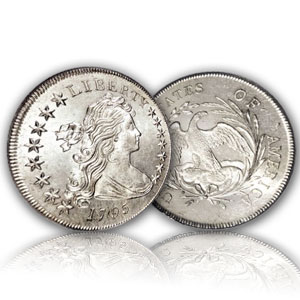
The Draped Bust dollar is a United States dollar coin minted from 1795 to 1803, and again into the 1850s. The design succeeded the Flowing Hair dollar, which began mintage in 1794 and was the first silver dollar struck by the United States Mint. The designer is unknown, though the distinction is usually credited to artist Gilbert Stuart. The model is also unknown, though Ann Willing Bingham has been suggested.
In October 1795, newly appointed Mint Director Elias Boudinot ordered that the legal fineness of .892 (89.2%) silver be used for the dollar rather than the unauthorized fineness of .900 (90%) silver that had been used since the denomination was first minted in 1794.
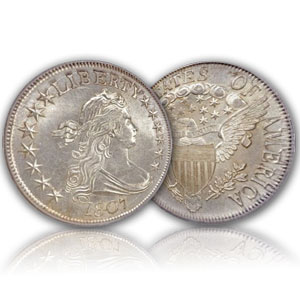
Due largely to a decrease in the amount of silver deposited at the Philadelphia Mint, coinage of silver dollars declined throughout the latter years of the 18th century. In 1804, coinage of silver dollars was halted; the last date used during regular mint production was 1803.
In 1834, silver dollar production was temporarily restarted to supply a diplomatic mission to Asia with a special set of proof coins. Officials mistakenly believed that dollars had last been minted with the date 1804, prompting them to use that date rather than the date in which the coins were actually struck. A limited number of 1804 dollars were struck by the Mint in later years, and they remain rare and valuable.
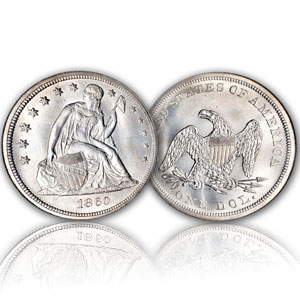
The Seated Liberty dollar was a one-dollar coin struck by the United States Mint from 1840 to 1873 and designed by its chief engraver, Christian Gobrecht. It was the last silver coin of that denomination to be struck before passage of the Coinage Act of 1873, which temporarily ended production of the silver dollar for American commerce. The coin's obverse is based on that of the Gobrecht dollar, which had been minted experimentally from 1836 to 1839. However, the soaring eagle used on the reverse of the Gobrecht dollar was not used; instead, the United States Mint (Mint) placed a heraldic eagle, based on a design by late Mint Chief Engraver John Reich first used on coins in 1807.
Seated Liberty dollars were initially struck only at the Philadelphia Mint; in 1846, production began at the New Orleans facility. In the late 1840s, the price of silver increased relative to gold because of an increase in supply of the latter caused by the California gold rush; this led to the hoarding, export, and melting of American silver coins. The Coinage Act of 1853 decreased the weight of all silver coins of five cents or higher, except for the dollar, but also required a supplemental payment from those wishing their bullion struck into dollar coins. As little silver was being presented to the Mint at the time, production remained low. In the final years of the series, there was more silver produced in the US, and mintages increased.
In 1866, "In God We Trust" was added to the dollar following its introduction to United States coinage earlier in the decade. Seated Liberty dollar production was halted by the Coinage Act of 1873, which authorized the Trade dollar for use in foreign commerce. Representatives of silver interests were unhappy when the metal's price dropped again in the mid-1870s; they advocated the resumption of the free coinage of silver into legal tender, and after the passage of the Bland-Allison Act in 1878, production resumed with the Morgan dollar.
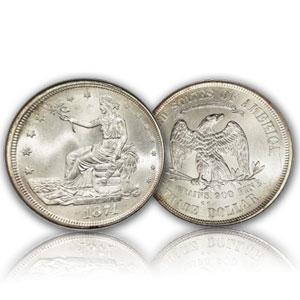
The trade dollar was produced in response to other Western powers, such as Great Britain, Spain, France, and particularly Mexico, to compete with these trade coins for use in trade in Asia. American trade dollars are 90% silver and weigh 420 grains (27.2 g), which is about 0.5 g heavier than the regular circulation Seated Liberty Dollars and Morgan Dollars. Most trade dollars ended up in Asia during their first two years of production, where they were very successful. Many of them exhibit chopmarks which are counterstamps from Asian merchants to verify the authenticity of the coins. Many trade coins of the western powers and large silver coins from China, Korea, and Japan also bear these chopmarks. While most chopmarked coins are generally worth less than those without, some of the more fascinating chopmarks can actually give the coin a modest premium.
Trade dollars did not circulate in the United States initially, but were legal tender for up to $5. Things changed, however, in 1876, when the price of silver spiraled downward as western producers dumped silver on the market, making the trade dollar worth more at face value than its silver content. That resulted in trade dollars pouring back into the United States, as they were bought for as little as the equivalent of 80 US cents in Asia, and were then spent at $1 in the United States. This prompted Congress to revoke their legal tender status, and restrict their coinage to exportation demand only. However, this did not stop unscrupulous persons from buying trade dollars at bullion value, and using them for payment as $1 to unsuspecting workers and merchants.
Production of the trade dollar was officially halted for business strikes in 1878, and thereafter from 1879–1885, produced only as proof examples of the coin. The issues of 1884 and 1885 were produced surreptitiously, and were unknown to the collecting public until 1908. In February 1887, all non-mutilated outstanding trade dollars were made redeemable to the United States Treasury, and approximately 8 million of them were turned in.
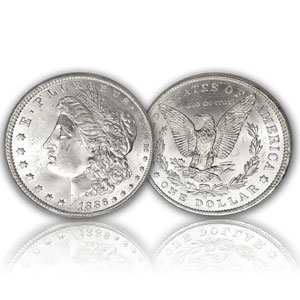
Morgan silver dollars were minted between 1878 and 1921, with a notable break between 1905 and 1920. The 1921-dated coins are the most common, and there exists a substantial collector market for pristine, uncirculated specimens of the rarer dates and mint marks. Morgan dollars are second only to Lincoln Cents in collector popularity. The coin is named after George T. Morgan, its designer. Morgan dollars were minted at Philadelphia (no mint mark), New Orleans ("O" mint mark), San Francisco ("S" mint mark), Carson City ("CC" mint mark), and (in 1921 only) Denver ("D" mint mark). The mint mark is found on the reverse below the wreath, above the "O" in "DOLLAR".
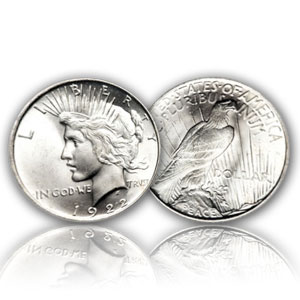
Introduced in December 1921, the Peace dollar, designed by medalist Anthony de Francisci, was promulgated to commemorate the signing of formal peace treaties between the Allied forces and Germany and Austria. These treaties officially ended the Allies' World War I hostilities with these two countries. In 1922 the Mint made silver dollar production its top priority, causing other denominations to be produced sparingly if at all that year. Production ceased temporarily after 1928; original plans apparently called for only a one-year suspension, but this was extended by the Great Depression. Mintage resumed in 1934, but for only two years.
In May 1965, 316,000+ Peace dollars were minted, all at the Denver Mint and dated 1964-D; however, plans for completing this coinage were abandoned, and most of those already minted were melted, with two known trial strike specimens being preserved (for assay purposes) until 1970, when they too were melted, and none released either for circulation or collection purposes. It is rumored that one or more pieces still exist, most notably any examples obtained by key members of Congress, the President, or mint officials. However, this coin, much like the 1933 $20 gold Double Eagle (aside from the "exception", sold in 2002 for over $7 million), is illegal to own and would be subject to confiscation.

From 1971 to 1978, the U.S. Mint issued dollar coins with the obverse depicting President Dwight David Eisenhower and the reverse the insignia of the Apollo 11 moon landing, both designed by Chief Engraver Frank Gasparro. The 1976 Bicentennial commemorative design, produced in 1975 and 1976, featured the Liberty Bell and the Moon on the reverse (designed by Dennis R. Williams), while retaining the Eisenhower obverse, and the dual dates 1776–1976. The Eisenhower dollars minted for general circulation contained no silver or gold, but were instead composed of the same copper-nickel clad composition used for the dime, quarter, and half dollar. This made the circulation coins extremely resistant to wear and, like the smaller denominations, they still retain a good deal of shine even when subject to mass usage.
From 1971 through 1976 the Mint also produced dollars composed of 40% silver aimed at the collector market. The 1971–74 issues appeared in brown boxes or blue packages, depending on whether they were proof or uncirculated. Somewhat different Bicentennial sets were produced in the following two years. All issues remain very common.
The coins were never very popular, primarily due to their large size and weight which made them inconvenient to carry and the fact that very few vending machines were designed to accept them. They saw the greatest use in casinos, and one-dollar tokens in United States casinos still approximate the size and weight of the coins. Prior to the withdrawal of the coins, which remain legal tender (and are sometimes available at banks by request) many casinos did not strike their own tokens, but instead used the Eisenhower dollar.
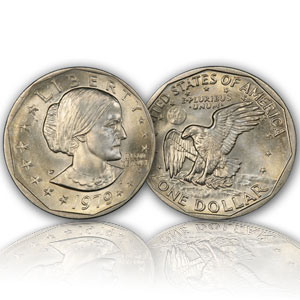
From 1979 to 1981, and again in 1999, the Mint produced Anthony Dollars, depicting Susan B. Anthony, the first non-fictitious woman portrayed on circulating U.S. coinage. (Many earlier circulating coins featured images of women, but the women depicted were all non-specific representations of Liberty. Spain's Queen Isabella was portrayed on the 1893 Columbian Exposition quarter dollar, but it was not intended as a circulating coin, although some did circulate.) The Anthony dollars, like the Eisenhower dollars, were made from a copper-nickel clad. The 1981 coins were issued for collectors only, but occasionally show up in circulation.
The Anthony dollar was often confused with the quarter based on color, size, and design. This is one reason why the coin was never popular. It was quickly discontinued, but resurrected in 1999 when Treasury reserves were low, and the Sacagawea dollar was still a year away from production. While reserves of the coins were initially high, the coins were in demand to be used as change in vending machines, most often in transit systems and post offices.
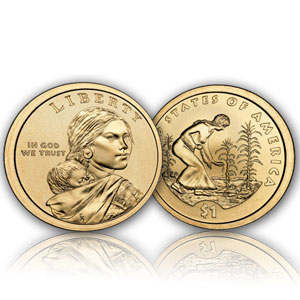
The Sacagawea dollar was authorized by Congress in 1997 because the supply of Anthony dollars, in inventory since their last mintage in 1981, was soon expected to be depleted. These coins have a copper core clad by manganese brass. Delays in increasing Sacagawea dollar production led to a final 1999-dated mintage of Susan B. Anthony dollars. Dollar coins are used infrequently in general commerce. They used to be given as change by United States Postal Service stamp vending machines, which created a relatively small but significant demand, but the USPS eliminated all those machines by 2010. They were also used in certain subway and public transit systems, like the "T" in Boston.
The obverse was designed by artist Glenna Goodacre. Since no verifiable image of Sacagawea exists, Goodacre used Randy'L He-dow Teton, a University of New Mexico college student and a Shoshone Indian, as a model for the coin.
There are approximately 1 billion Sacagawea coins in circulation, and about 250 million in reserve. The US Mint greatly reduced production of Sacagawea dollars after the 2001 minting, citing sufficient inventory. From 2002 to 2008 the Sacagawea dollar was still minted for collectors and was available in uncirculated rolls, mint sets, and proof sets, but it was not released for general circulation until the introduction of the Native American series in 2009.
The Mint took great care to create the coin with the same size, weight, and electromagnetic properties as the Anthony dollar, but with a golden color. Unlike most other coins in circulation, the selected alloy has a tendency to tarnish quite severely in circulation, as is the case with most brasses, resulting in a loss of the golden shine, except on raised areas where the "patina" is more frequently rubbed off. While some consider the blackening an undesired quality, the Mint suggests the uneven tarnishing effect gives the coins an "antique finish" that "accentuate[s] the profile and add[s] a dimension of depth to the depiction of Sacagawea and her child". The coin featured a plain edge through 2008, but starting in 2009 incused lettering was applied. The year and mint mark moved from the coin's obverse (front) to its edge.
As of 2011, dollar coins are not widely encountered in US commerce, except in vending machines for rides on mass transit, some pay and display machines, some laundromats, and old-fashioned slot machines. Most vending machines and parking meters have been redesigned, however, to accept dollar coins for purchase over a quarter-dollar. The Sacagawea dollar has achieved popularity in El Salvador, Ecuador and Panama, where the US dollar is also the official currency.
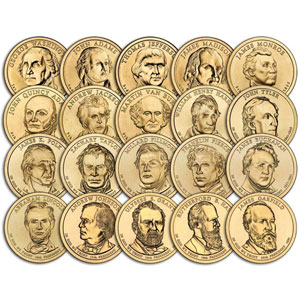
The Presidential $1 Coin Program is part of an Act of Congress, enacted December 22, 2005, which directs the United States Mint to produce $1 coins with engravings of relief portraits of U.S. presidents on the obverse. From 2007 to 2011, presidential $1 coins were minted for circulation in large numbers, resulting in a large stockpile of unused $1 coins. Since 2012, new presidential coins are only being minted for collectors, in order to reduce the stockpile.
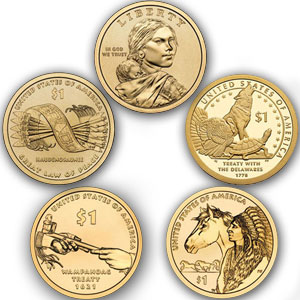
With the passage of the Native American $1 Coin Act on September 20, 2007, the U.S. Mint began designing a series of Sacagawea dollars with modified reverses to further commemorate "Native Americans and the important contributions made by Indian tribes and individual Native Americans to the development of the United States and the history of the United States". Four designs were to be minted, each for one year from 2009 to 2012. The first Native American series coin was released in January 2009 and had a reverse that depicted a Native American woman sowing seeds of the Three Sisters, symbolizing the Indian tribes' contributions to agriculture.
Like the Presidential Dollar, the year of issue, mint mark, and motto E Pluribus Unum are found on the edge of the coin instead of on the obverse or reverse, which allows for more room for the design. Unlike the Presidential $1 coins from before 2009, "In God We Trust" remains on the obverse and the vacant space on the edge lettering has been taken up by thirteen stars, symbolizing the Thirteen Colonies. Also, unlike any other denomination of circulating U.S. coinage (but in common with the Presidential $1 coins), the value is inscribed in numerals on the reverse. The act passed by Congress requires that 20% of the total dollar coins minted in any year during the Presidential $1 Coin Program be Sacagawea dollars bearing the new design.
In January 2010, the second reverse design in the series was released which has the theme of "Government" and the "Great Tree of Peace". The 2010 Sacagawea reverse depicts the Hiawatha Belt and five arrows bound together representing unity with the inscription "Haudenosaunee", a synonym for the Iroquois Confederacy meaning "People of the Longhouse". Another inscription is found along the lower edge of the reverse spelling "Great Law of Peace" (an English translation of Gayanashagowa, the Iroquois Confederacy constitution). The Great Law of Peace was used as a model for the Constitution of the United States. The four links on the belt are meant to symbolize four of the five Nations of the Iroquois Confederacy, namely the Mohawk, Oneida, Cayuga and Seneca Nations. The Eastern White Pine tree in the middle of the belt represents the fifth Nation, the Onondaga, and is a depiction of the Tree of Peace.